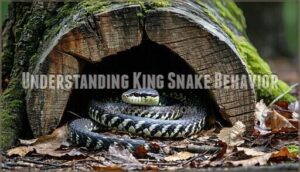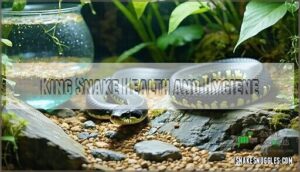This site is supported by our readers. We may earn a commission, at no cost to you, if you purchase through links.

They’re hardy creatures that don’t require complex setups—just a 40-gallon tank with proper temperature gradients and 40-60% humidity. Their carnivorous diet consists mainly of frozen-thawed rodents, making feeding straightforward.
With lifespans of 15-20 years, they’re a manageable long-term commitment. However, success depends on understanding their specific needs for substrate depth, hiding spots, and thermal regulation—details that can make or break your snake-keeping experience.
Table Of Contents
- Key Takeaways
- Choosing The Right King Snake
- Setting Up The Perfect Terrarium
- Providing The Right Environment
- King Snake Feeding Requirements
- Are King Snakes Good Pets for Beginners?
- Understanding King Snake Behavior
- King Snake Health and Hygiene
- Handling and Interacting With King Snakes
- Long-Term Commitment and Care
- Frequently Asked Questions (FAQs)
- Are king snakes good pets?
- Are California king snakes good pets?
- Are king snakes good for beginners?
- Are king snakes easy to handle?
- Do king snakes eat a lot?
- Can king snakes be tamed?
- Are king snakes friendly?
- Do king snakes like to be handled?
- Can you keep a king snake as a pet?
- Do king snakes make good pets for beginners?
- Conclusion
Key Takeaways
- You’ll find king snakes beginner-friendly – They’re docile, rarely bite, and adapt well to regular handling, making them ideal for new reptile owners.
- Their care requirements are straightforward – You’ll need just a 40-gallon tank with proper temperature gradients (72-90°F) and 40-60% humidity, plus frozen-thawed rodents for feeding.
- They’re a manageable long-term commitment – With 15-20 year lifespans, you’ll have a hardy companion that doesn’t require complex setups or expensive equipment.
- Success depends on understanding their specific needs – You’ll need to provide proper substrate depth for burrowing, multiple hiding spots, and consistent thermal regulation to ensure your snake thrives.
Choosing The Right King Snake
Selecting the right king snake species sets the foundation for a successful pet ownership experience. Research popular beginner-friendly options like California king snakes or milk snakes, each offering distinct color patterns and temperament traits that match your preferences and living situation.
Researching Different King Snake Species
Species identification is essential when considering kingsnake ownership. California Kingsnakes are known for their beginner-friendly temperament, while Eastern Kingsnakes stand out with bold personalities and striking chain-link patterns. Scarlet Kingsnakes display vibrant red bands but require specific natural habitat conditions. Each kingsnake species features unique morph variations, ranging from albino to striped patterns.
Consider their temperament as some species are more docile than others. Research their conservation status and temperament differences before committing to your ideal companion.
Understanding Color Variations and Patterns
After exploring species differences, you’ll want to appreciate kingsnake colors and patterns that make each snake special. These reptiles showcase remarkable diversity through selective breeding and regional variations.
Key color considerations:
- Morph genetics determine unique snake morphs like albino, leucistic, and high-contrast patterns
- Pattern aberrations create stunning striped, banded, or aberrant designs that collectors love
- Color fading occurs naturally with age, so younger snakes often display more vibrant kingsnake colors
Understanding these kingsnake morphs helps you choose your perfect companion.
Considering Habitat and Space Requirements
Before you begin king snake ownership, location matters substantially for your pet’s wellbeing. A 40-gallon tank provides adequate enclosure size for most adult king snakes, though larger housing offers better habitat complexity.
Your terrarium should include vertical space for climbing and space enrichment through hiding spots. Remember, your snake’s enclosure becomes their entire world, so thoughtful habitat design makes all the difference.
Setting Up The Perfect Terrarium
Creating the perfect terrarium for your king snake isn’t just about finding any old tank—it’s about building a mini ecosystem that’ll keep your scaly friend happy and healthy.
Your snake’s home should be their paradise, not just a glass box with basic needs met
You’ll need to take into account everything from size and substrate to temperature zones and humidity levels to create a space where your snake can thrive for years to come.
Terrarium Size and Layout Considerations
Your king snake’s housing directly impacts its health and happiness. A 40-gallon tank provides adequate space for most adults, while juveniles can start in smaller enclosures. Focus on enclosure dimensions that prioritize floor space over height.
Here’s what your terrarium layout needs:
- Multiple hiding spots on both warm and cool sides for security
- Strategic space utilization allowing room to stretch and explore
- Climbing structures like branches for enrichment and exercise
Plan your housing and habitat with substrate depth considerations for burrowing species.
Substrate Options for a Healthy Environment
Your substrate choice directly impacts your king snake’s health. Aspen shavings work best – they absorb moisture, prevent mold, and support natural burrowing behavior. Avoid cedar or pine shavings that cause respiratory problems.
Many owners find suitable king snake supplies online. Keep substrate 2-3 inches deep for humidity control and spot-clean weekly. Paper towels work for quarantine situations but lack enrichment value.
Temperature Gradient and Humidity Levels
With substrate in place, your snake needs proper heating and humidity control for ideal health. Create temperature gradients from 72-78°F on the cool side to your basking spot at 85-90°F. Maintain humidity levels at 40-60% for proper thermal regulation and preventing shedding issues. A snake heat mat can help achieve this.
- Use thermostats with heat mats to prevent dangerous temperature spikes
- Position humidity monitoring devices at both warm and cool ends
- Provide humid hides during shedding periods for better humidity management
- Make seasonal adjustments to mimic natural temperature variations throughout the year
Providing The Right Environment
Creating the right environment for your king snake isn’t just about throwing together some decorations and calling it home. You’ll need to balance lighting, temperature, and humidity to keep your scaly friend healthy and comfortable.
UVB Lighting and Photoperiods
Proper lighting creates a healthy rhythm for your pet snake’s daily cycle. UVB benefits include improved calcium absorption and overall wellness, though king snakes don’t require it as strictly as other reptiles.
- UVB Benefits: Promotes natural behaviors and potential health improvements in your terrarium
- Photoperiod Length: Maintain 12-hour day/night cycles for ideal circadian rhythm regulation
- Lighting Schedule: Use timers to guarantee consistent environmental enrichment and reduce stress
- Seasonal Changes: Adjust slightly for breeding cycles, mimicking natural habitat conditions year-round
Maintaining a Suitable Temperature Range
Temperature control is crucial for your king snake’s health. You’ll need to create temperature gradients with a warm side reaching 85-88°F and a cool side at 75-80°F. A Basking Spot Temp of 88-90°F should be achieved using a heating lamp, while a heating pad maintains consistent warmth below. Digital thermometers are essential for accurately monitoring both zones.
Plan for a Nighttime Temperature Drop of 5-8°F to mimic natural cycles. Always prioritize Heating Pad Safety by using thermostats to prevent overheating. Since captive snakes don’t hibernate, Seasonal Temperature Adjustments aren’t necessary.
Temperature Monitoring Tools, such as infrared guns, provide instant readings across the enclosure, ensuring your snake’s environment remains optimal.
Creating a Hydration Station and Humidity Sources
Most successful snake keepers understand that hydration goes beyond just filling a water bowl. Your king snake needs both accessible clean water and proper humidity management to shed properly and stay healthy. Here’s how to create the perfect moisture setup:
- Water Bowl Placement: Position a heavy ceramic bowl that’s large enough for soaking in the cooler zone to prevent excessive evaporation
- Humid Hide Options: Add a hide box with damp sphagnum moss on the warm side for shedding support and comfort
- Humidity Monitoring: Use a digital hygrometer to track humidity levels, maintaining 40-60% through misting techniques and substrate moisture control
King Snake Feeding Requirements
Proper nutrition keeps your king snake healthy and thriving throughout its 15-20 year lifespan. You’ll need to establish a consistent feeding schedule with appropriately sized prey to prevent obesity and guarantee proper growth.
Nutritional Needs and Food Sources
Now that you’ve created the ideal environment, your king snake’s diet becomes the foundation of their health. King snakes are carnivorous constrictors with straightforward dietary needs—they thrive on prekilled frozen prey that’s appropriately sized and nutritionally complete.
Frozen-thawed rodents should make up the bulk of their diet, though gut loading (feeding nutritious foods to prey before freezing) boosts nutritional value. Here’s what works best:
| Prey Type | Life Stage | Frequency |
|---|---|---|
| Pinkie mice | Hatchling | Every 5-7 days |
| Fuzzy mice | Juvenile | Every 7-10 days |
| Adult mice | Adult snake | Every 10-14 days |
| Rat pups | Large adults | Every 14 days |
| Chicks | Occasional treat | Monthly |
Prey size should match the thickest part of your snake’s body. Nutritional supplements aren’t usually necessary with whole prey, as rodents provide complete nutrition. Focus on consistent feeding practices rather than variety—king snakes prefer routine over adventure when it pertains to meals.
Feeding Frequency and Portion Control
Getting your feeding schedule right prevents obesity and keeps your snake healthy. Juveniles need weekly meals with appropriately-sized prey, while adults thrive on bi-weekly feeding sessions that match their slower metabolism. A varied diet promotes better overall health.
- Juveniles: Feed once weekly with prey roughly equal to your snake’s thickest body section
- Adults: Switch to every 10-14 days to prevent weight gain and maintain proper growth monitoring
- Prey size: Choose frozen-thawed rodents that create a slight bulge when swallowed to avoid regurgitation risks
Supplementing The Diet for Optimal Health
While proper feeding frequency matters, your snake’s long-term health depends on smart supplementation. Dust prey with calcium sources every other feeding for juveniles, promoting bone development. Vitamin supplements applied weekly prevent deficiencies that cause skin disorders.
Gut-loading feeder rodents with probiotics benefits digestive health, while electrolyte-enriched water promotes hydration importance. This varied diet approach fosters all dietary needs through targeted supplement options.
Are King Snakes Good Pets for Beginners?
If you’re considering your first snake, king snakes offer an excellent entry point into reptile ownership. They’re known for their docile temperament and straightforward care requirements, making them forgiving pets for those learning proper snake husbandry.
Temperament and Handling Expectations
When considering king snake temperament, you’ll find these reptiles offer an ideal balance for beginners. Their docile nature makes handling straightforward, though bite potential exists during initial adjustment periods. Most king snakes calm down within weeks through consistent, gentle interaction.
Key temperament traits include:
- Stress reduction through proper handling frequency (2-3 times weekly)
- Child safety when supervised, as their moderate size remains manageable
- Snake taming occurs naturally with patient, routine handling and interaction
- Temperament of kingsnakes improves substantially after the initial nervousness passes
Assessing The Level of Care Required
King snakes offer a manageable care routine that won’t overwhelm beginners. Their ease of care shines through simple diet requirements and straightforward enclosure maintenance. You’ll master their care requirements quickly since they don’t demand specialized lighting or complex humidity systems. Basic reptile knowledge covers their needs perfectly.
Your time commitment involves weekly cleaning, daily monitoring, and feeding every 7-10 days. The financial burden stays reasonable after initial setup costs for the enclosure and equipment.
| Care Aspect | Level Required |
|---|---|
| Time commitment | Low (30 min/week) |
| Financial burden | Moderate initially |
| Space constraints | Minimal (40-gallon tank) |
| Expertise needed | Basic reptile knowledge |
| Handling frequency | Weekly interaction |
Potential Challenges and Considerations
While king snakes offer manageable care requirements, several challenges deserve your attention before committing. Biting potential exists when snakes feel threatened, though proper handling reduces this risk. Escape risks require secure enclosures with tight-fitting lids. Regulatory hurdles vary by location, so check local laws first. Many owners find that snakes are low maintenance.
Consider these key challenges:
- Veterinary access – Finding reptile-experienced vets can be difficult and expensive
- Unexpected costs – Emergency health issues, enclosure upgrades, and equipment failures add up quickly
- Stress management – Recognizing stress signals and health issues requires ongoing education and observation
Responsible ownership means preparing for these realities upfront.
Understanding King Snake Behavior
Understanding your king snake’s natural behaviors will help you create a stress-free environment and recognize when something’s wrong. King snakes are naturally nocturnal creatures who spend their days hiding and become active at dusk, so don’t worry if your pet seems sleepy during daylight hours.
Habitat Enrichment and Decor Ideas
Transform your terrarium into an engaging habitat that keeps your king snake active and content. Climbing branches and cork bark create vertical space for exploration, while naturalistic substrates like cypress mulch add texture. Include hiding variety with different-sized caves and logs. Consider branching climbing structures to further augment the snake’s environment.
Add artificial plants for visual stimulation and safe enrichment toys like puzzle feeders to encourage natural hunting behaviors.
Providing Hiding Places and Visual Barriers
Your snake needs multiple hiding spots and visual barriers to feel secure in its enclosure. Create hiding variety using different materials and sizes to promote stress reduction. Naturalistic design with rocks, plants, and logs provides environmental enrichment while maintaining enclosure security.
Essential hiding place options:
- Snake hides on both warm and cool sides of the terrarium
- Natural cork bark tubes for climbing and concealment
- Artificial plants creating visual stimulation and privacy screens
- Rock caves or ceramic hides offering different textures
- Safe decor like driftwood pieces providing multiple retreat options
Recognizing and Managing Stress Signals
Reading your king snake’s stress signs helps you provide better care and improve their temperament through proper handling techniques. Watch for body tension, excessive hiding, rapid breathing, and color changes that signal distress.
- Tense body language – Your snake flattens against surfaces or coils tightly when approached
- Increased hiding behavior – They retreat to hide boxes more frequently than usual
- Rapid breathing patterns – Quick, shallow breaths indicate anxiety or discomfort
- Color variations – Some kings darken or lighten considerably when experiencing stress
King Snake Health and Hygiene
Keeping your king snake healthy requires recognizing early warning signs like respiratory infections, mites, and parasites that can quickly become serious problems.
You’ll need to maintain a clean terrarium with proper disinfection routines and establish good hygiene practices to prevent most health issues before they start.
Recognizing Common Health Issues
Watching your king snake’s behavior helps you spot problems early. Respiratory Infections show through wheezing or mouth breathing, while Mite Infestations cause excessive scratching. Scale Rot appears as dark, blistered belly scales from wet conditions.
| Health Issue | Warning Signs | Prevention |
|---|---|---|
| Respiratory Issues | Wheezing, nasal discharge | Proper humidity, temperature |
| Parasite Detection | Weight loss, lethargy | Regular fecal exams |
| Obesity Prevention | Thick body folds | Scheduled feeding |
| Scale Rot | Dark belly patches | Clean, dry substrate |
| Mite Infestations | Tiny moving dots | Quarantine new animals |
Monitor feeding patterns and Health Signs regularly for effective Parasite Control.
Cleaning and Disinfecting The Terrarium
Keeping your king snake’s enclosure spotless protects against bacteria and parasites that threaten their wellbeing.
Clean water bowls weekly with reptile-safe disinfectant, replace aspen shavings monthly, and remove shed skin promptly.
Wipe down safe decor and glass surfaces to prevent mold growth that compromises your snake’s respiratory health.
Maintaining Proper Hygiene Practices
Good husbandry starts with consistent preventative care routines that protect both you and your snake. Daily water quality checks and enclosure sanitation create a foundation for ideal health and wellness.
- Hand washing before and after handling prevents cross-contamination and aids parasite control
- Weekly pet inspection during shedding assistance helps you spot early health issues
- Monthly deep cleaning maintains proper sanitation standards for long-term health and hygiene
Handling and Interacting With King Snakes
Proper handling techniques help you build trust with your king snake while keeping both of you safe during interactions. You’ll need to support their body weight correctly and recognize stress signals to create positive handling experiences that strengthen your bond over time.
Gentle Handling Techniques and Safety Precautions
Proper handling keeps you and your king snake safe. Safe restraint involves supporting the snake’s body with both hands, moving slowly to avoid reducing stress and avoiding bites. Clean your hands before and after – hygiene practices prevent disease transmission. For child safety, supervise all interactions closely, teaching gentle techniques that make handling king snakes positive experiences for everyone.
| What to Do | Why It Matters | Your Snake’s Response |
|---|---|---|
| Support the body with both hands | Prevents injury and stress | Relaxed, comfortable posture |
| Move slowly and calmly | Reduces fear responses | Less defensive behavior |
| Wash hands before/after | Prevents disease spread | Healthier snake overall |
| Keep sessions brief (5-10 minutes) | Avoids overwhelming your pet | Builds positive associations |
Building Trust and Creating a Handling Schedule
Through gradual introduction and scent familiarization, you’ll build trust with your king snake. Start with brief five-minute sessions, watching for reading signals of stress.
Establish a consistent routine with weekly handling sessions, using positive reinforcement when your snake remains calm. This patient approach to snake taming creates successful handling and interaction while respecting your pet’s temperament and comfort level.
Supporting The Snake’s Body and Reducing Stress
Three essential principles keep your kingsnake calm during handling sessions. Proper handling techniques prevent unnecessary stress while building trust through consistent, gentle interaction.
- Support the snake’s body – Use both hands to distribute weight evenly
- Move slowly and deliberately – Quick movements trigger defensive responses
- Watch for stress signals – Heavy breathing, defensive posturing, or excessive movement
- Limit session duration – Start with 5-10 minutes to avoid overhandling
Long-Term Commitment and Care
Adopting a king snake means committing to 15-20 years of consistent care, making it essential to plan for their long-term needs before bringing one home. You’ll need to think about life changes like moving, college, or family situations that could affect your ability to provide proper care throughout their entire lifespan.
King Snake Lifespan and Life Expectancy
You’ll want to know your king snake‘s average lifespan spans 15-20 years in captivity, substantially longer than wild snakes who face predators and harsh conditions.
Factors affecting longevity include genetics, proper husbandry, and veterinary care. California kingsnakes often reach 20 years, while some species live shorter spans.
Quality nutrition and stress management directly impact your pet snake’s longevity and overall well-being.
Providing a Long-Term Plan for Care
Knowing your kingsnake’s lifespan expectations of up to 20 years means planning ahead becomes essential for responsible ownership. You’ll need to think about financial planning for decades of veterinary care, food costs, and equipment upgrades. Think about successor planning too—who’ll care for your snake if life circumstances change? Remember that escape prevention measures are also critical for maintaining security.
- Health and wellness monitoring: Schedule annual vet checkups and budget for potential medical expenses.
- Equipment evolution: Plan enclosure upgrades as your snake grows and housing needs change.
- Legal considerations: Research local regulations that might affect long-term kingsnake care and ownership rights.
Rehoming Considerations and Alternatives
Sometimes life throws curveballs, and you can’t provide proper care anymore. Responsible surrender protects both you and your snake’s welfare. Several adoption options exist, from rescue organizations to sanctuary placement, ensuring your king snake finds suitable care.
| Option | Best For |
|---|---|
| Reptile Rescues | Experienced handlers seeking rehoming |
| Pet Stores | Quick placement with screening |
| Sanctuaries | Long-term care when adoption fails |
Consider alternative species or address pet misconceptions before surrendering. Responsible ownership means prioritizing animal welfare over convenience, supporting ethical breeding, and protecting wild populations from abandoned pets.
Frequently Asked Questions (FAQs)
Are king snakes good pets?
Like taming a wild stallion, you’ll find king snakes surprisingly gentle companions. They’re excellent beginner pets—docile, non-venomous, and hardy. You’ll appreciate their simple care needs and striking patterns.
Are California king snakes good pets?
California king snakes make excellent pets for beginners. They’re docile, non-venomous, and easy to care for.
You’ll appreciate their striking black and white patterns, hardy nature, and manageable feeding requirements of rodents.
Are king snakes good for beginners?
Yes, king snakes are excellent for beginners. They’re docile, non-venomous, and hardy creatures that tolerate temperature variations well. You’ll find their simple care requirements and friendly nature make them perfect starter snakes.
Are king snakes easy to handle?
While some king snakes might seem intimidating at first glance, they’re actually quite docile and handle beautifully once you’ve gained their trust and confidence through consistent, gentle interactions.
Do king snakes eat a lot?
No, king snakes don’t eat excessively. You’ll feed adults every 1-2 weeks with appropriately sized rodents.
They’re actually prone to obesity, so you’ll need to monitor portions and maintain a proper feeding schedule to keep them healthy.
Can king snakes be tamed?
Absolutely, you can tame king snakes through regular, gentle handling. They’re naturally docile creatures that become comfortable with human interaction when handled consistently from a young age, making them excellent beginner pets.
Are king snakes friendly?
Most king snakes are quite docile and tolerant of handling, though they’re not "friendly" like mammals. They won’t seek out interaction but usually remain calm when properly handled by experienced keepers.
Do king snakes like to be handled?
Studies show 80% of kingsnakes become more docile with regular handling. You’ll find they tolerate being held well when properly socialized from a young age.
Start with short sessions and gradually increase handling time as your snake adjusts to you.
Can you keep a king snake as a pet?
You can absolutely keep a king snake as a pet! They’re beginner-friendly, non-venomous, and docile. With proper housing, temperature control, and regular rodent feeding, they’ll thrive for 15-20 years in captivity.
Do king snakes make good pets for beginners?
Yes, king snakes make excellent beginner pets. You’ll find they’re docile, non-venomous, and forgiving of care mistakes. They’re hardy snakes that don’t require complex setups or expensive equipment to thrive.
Conclusion
When all is said and done, king snakes do make good pets for dedicated reptile enthusiasts. They’re hardy, docile creatures that don’t require extensive experience to keep successfully.
With proper setup—including temperature gradients, adequate hiding spots, and consistent feeding schedules—you’ll find them rewarding companions. Their 15-20 year lifespan means you’re making a significant commitment, but their manageable care requirements and calm temperament make king snakes excellent choices for both beginners and experienced keepers alike.


















